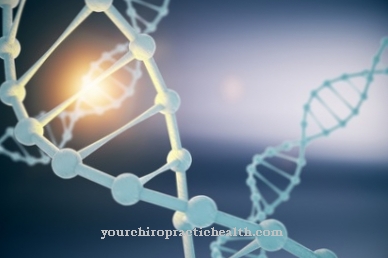The Dissimilation represents one of the most central processes in the organism of every breathing living being. It ensures the maintenance and intact function of the entire metabolism, cardiovascular system and central nervous system. In the event of a disturbed process, this importance also results in the presence of many serious consequences and symptoms of illness.
What is dissimilation?

The term "dissimilation" is derived from the Latin expression 'dissimilis' (= dissimilar) or 'dissimilatio' (= making dissimilar). Dissimilation is based on the enzymatic breakdown of the body's own substances, which are initially absorbed through food. These include, for example, fats and carbohydrates as well as glucose.
Following their breakdown, the exogenous substances that are now present are excreted in the form of water and carbon (dioxide). Furthermore, large amounts of energy are obtained during the entire dissimilation process, which the cells store and process in the form of the universal energy carrier adenosine triphosphate (ATP).
The number of ATP molecules obtained is 38 per molecule of glucose. There is also a differentiation between oxidative energy gain (= reaction process with oxygen), also called aerobic respiration, and anaerobic respiration (= without the influence of oxygen). The latter is mainly known as fermentation in everyday parlance.
Function & task
Dissimilation takes place in the cells of the human body. It comprises the four sub-steps glycolysis, oxidative decarboxylation, citric acid cycle and the final respiratory chain, also known as end oxidation.
Apart from glycolysis, which takes place in the cell plasma, all other sub-processes take place in the mitochondria or on their inner membrane. Mitochondria are small cell organelles that are enclosed by a double membrane and thus isolated from the cytoplasm. If a person ingests glucose through food, an energy expenditure phase begins in which a phosphate group attaches to the sixth carbon atom of the glucose molecule. This comes from a previous breakdown of a molecule of ATP into ADP (= adenosine diphosphate). After the same process is repeated, the glucose with its six carbon atoms breaks down into two molecules with three carbon atoms each.
The energy release phase then begins. The phosphates break away from the carbon atoms and combine with ADP to form ATP. Water molecules are split off and an energy-rich reduction of the substance NAD to NADH + H + takes place. The last-named products are called “reduction equivalents” and are used to transfer and store electrons.
The oxidative decarboxylation follows. Here, too, there is initially a comparable reduction; however, the original glucose molecule then combines with a coenzyme in order to be able to enter the citric acid cycle.
Fats first pass through the fatty acid cycle and then enter the citric acid cycle at a suitable point. Here the molecule goes through a series of different, new connections and splitting off of atoms. All of these processes primarily contribute to providing enough further electron carriers for the end oxidation and to disposing of the carbon dioxide, which is toxic to humans.
The reduction equivalents arrive at the inner mitochondrial membrane and in the gap between the inner and outer membrane (= intermembrane space) and oxidize. As a result, electrons on the inner membrane are channeled through various protein complexes and hydrogen protons are pumped into the space in between. These combine with oxygen atoms and leave the cell as a water molecule.
From an energetic point of view, the respiratory chain represents the most important part of the entire dissimilation process. The forces and differences in concentration between the inner and outer milieu of the mitochondrion result in the formation of 34 molecules of ATP.
You can find your medication here
➔ Medication for shortness of breath and lung problemsIllnesses & ailments
In order for such a high number of ATP to be generated, sufficient oxygen must be available. However, under anaerobic conditions, i.e. during fermentation, this is missing, so that the end oxidation cannot take place. This in turn means that only ten percent of the energy is obtained with the same energy input, since ultimately only four of the actual 38 molecules of ATP can be obtained.
Such (lactic acid) fermentation occurs, for example, during exercise or comparable physical exertion. This becomes noticeable by the painful burning of the muscles, as these are downright acidic due to the excess and not completely broken down products.
Permanently disrupted energy production, for example due to the lack of appropriate coenzymes, insufficient oxygen supply from outside or the intake of pollutant-rich water, can lead to cancer in the case of hardship. Such a disorder can be recognized at an early stage based on the reduced body temperature of the person affected. The release of heat is ultimately accompanied by the generation of energy.
But less drastic complaints can also be the result of a briefly reduced oxygen supply to the cells. A deficiency in the cells of the brain leads to concentration problems and fatigue. At the same time, the deficiency in the heart, lungs and arteries can cause extreme exhaustion and circulatory problems up to collapse.
In addition, the entire immune system is weakened by the lack of oxygen in the cells, so that an increased susceptibility to all diseases must be assumed.
The central nervous system also consists of cells that promote dissimilation, the neurons. Since these also do not work correctly in the event of incomplete dissimilation and may become over-acidic, the nervous system can be over-excited. This manifests itself in the form of nervousness, irritability up to muscle tremors and muscle pain. Stress and overstimulation can also be the cause of disturbed dissimilation.
In order to counteract a chronic disorder of dissimilation in the entire organism, it is advisable to ensure a healthy, balanced diet and sufficient exercise, ideally in the fresh air. It is also important to avoid unnecessary physical and emotional stress.





.jpg)







.jpg)

.jpg)
.jpg)











.jpg)